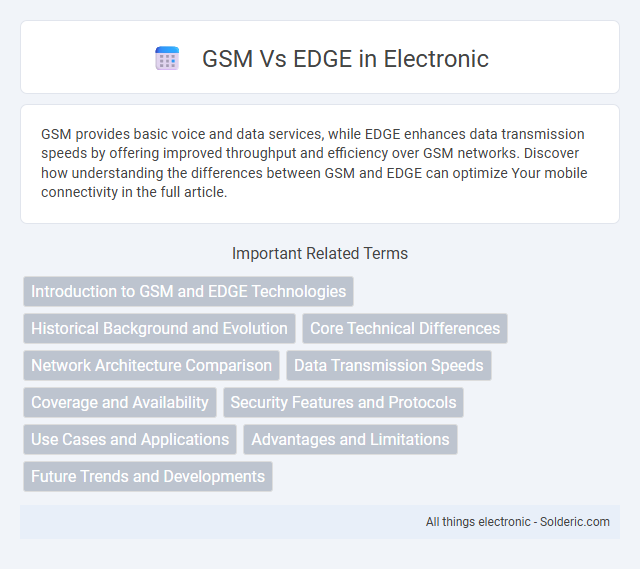GSM provides basic voice and data services, while EDGE enhances data transmission speeds by offering improved throughput and efficiency over GSM networks. Discover how understanding the differences between GSM and EDGE can optimize Your mobile connectivity in the full article.
Comparison Table
| Feature | GSM (Global System for Mobile Communications) | EDGE (Enhanced Data rates for GSM Evolution) |
|---|---|---|
| Technology Type | 2G digital cellular network | Enhanced 2G technology (2.75G) |
| Data Transfer Speed | Up to 14.4 kbps | Up to 384 kbps |
| Modulation Technique | GMSK (Gaussian Minimum Shift Keying) | 8PSK (8 Phase Shift Keying) |
| Network Compatibility | Supported on most 2G GSM networks worldwide | Backward compatible with GSM networks |
| Applications | Voice calls, SMS, basic data services | Faster internet browsing, multimedia messaging (MMS), email |
| Latency | Higher latency | Lower latency than GSM |
| Release Year | Early 1990s | Late 1990s |
Introduction to GSM and EDGE Technologies
GSM (Global System for Mobile Communications) is a widely adopted 2G cellular technology that provides voice communication and basic data services using TDMA-based transmission. EDGE (Enhanced Data rates for GSM Evolution) is an advanced enhancement of GSM, offering increased data speeds up to 384 kbps by utilizing improved modulation techniques like 8PSK. Both technologies operate on the same GSM network infrastructure but differ primarily in data transmission capabilities, enabling EDGE to support faster mobile internet access and multimedia services.
Historical Background and Evolution
GSM (Global System for Mobile Communications) originated in the 1980s as a 2G digital cellular network standard, revolutionizing mobile communication with enhanced voice quality and international roaming capabilities. EDGE (Enhanced Data rates for GSM Evolution) emerged in the late 1990s as a backward-compatible upgrade to GSM, introducing higher data transmission speeds through improved modulation techniques like 8PSK. This evolution marked a critical transition from primarily voice-centric services to data-oriented mobile networks, paving the way for 3G technologies.
Core Technical Differences
GSM (Global System for Mobile Communications) operates primarily as a 2G digital cellular network using TDMA (Time Division Multiple Access) to divide frequency bands and support voice and basic data services. EDGE (Enhanced Data rates for GSM Evolution) enhances GSM by introducing a new modulation scheme called 8PSK (8 Phase Shift Keying), which significantly increases data transmission rates up to three times compared to standard GSM's GMSK (Gaussian Minimum Shift Keying). The core technical difference lies in EDGE's improved coding and modulation techniques that enable higher throughput and better spectral efficiency while maintaining backward compatibility with existing GSM infrastructure.
Network Architecture Comparison
GSM architecture is based on a circuit-switched network with base transceiver stations (BTS) connected to base station controllers (BSC), which manage radio resources and handoffs within a mobile switching center (MSC). EDGE enhances GSM by integrating improved modulation techniques and coding schemes within the same network infrastructure, allowing higher data rates without major changes to the existing GSM architecture. This backward-compatible enhancement supports packet-switched data transmission alongside traditional circuit-switched voice services, enabling faster mobile broadband access within the established GSM framework.
Data Transmission Speeds
GSM (Global System for Mobile Communications) supports data transmission speeds up to 14.4 kbps, primarily designed for voice communication and basic data services. EDGE (Enhanced Data rates for GSM Evolution) significantly improves upon GSM by offering speeds up to 384 kbps, enabling faster web browsing, email, and multimedia messaging on mobile devices. Your mobile experience benefits from EDGE's enhanced data rates, providing more reliable and efficient connectivity compared to standard GSM networks.
Coverage and Availability
GSM networks offer extensive global coverage, making them widely available in urban and rural areas across multiple continents. EDGE technology, an enhancement of GSM, provides improved data transmission speeds but relies on the underlying GSM infrastructure for coverage. While GSM focuses primarily on voice and basic data services, EDGE extends availability with faster mobile internet access without sacrificing the broad reach of GSM networks.
Security Features and Protocols
GSM employs A5/1, A5/2, and A5/3 encryption algorithms to secure voice and data transmissions, offering basic protection against eavesdropping. EDGE enhances security by integrating stronger encryption standards and improved key management, bolstering data integrity and confidentiality in mobile communications. Your mobile network's security depends on these protocols to safeguard call privacy and prevent unauthorized access.
Use Cases and Applications
GSM (Global System for Mobile Communications) is primarily used for basic voice calls and low-speed data services in mobile networks, making it suitable for standard telephony and text messaging applications. EDGE (Enhanced Data rates for GSM Evolution) enhances GSM networks by providing higher data transmission rates, enabling more advanced mobile internet access, multimedia messaging, and moderate-speed data applications such as email and light web browsing. GSM is ideal for voice-centric services in areas with limited network infrastructure, while EDGE supports improved data services in regions where enhanced mobile internet connectivity is required without the deployment of 3G or 4G technologies.
Advantages and Limitations
GSM offers widespread global coverage and reliable voice communication with lower power consumption, making it ideal for basic mobile connectivity. EDGE enhances data transmission speeds up to three times faster than GSM by employing improved modulation techniques, supporting better internet browsing and multimedia messaging. However, GSM's slower data rates limit modern applications, while EDGE's increased speed still falls short of 3G and 4G standards, restricting high-bandwidth usage like video streaming.
Future Trends and Developments
GSM networks, foundational for early mobile communication, are gradually being phased out in favor of more advanced technologies like EDGE, which offers enhanced data transmission speeds up to 384 kbps by utilizing improved modulation techniques. Future trends indicate a shift towards LTE and 5G, but EDGE remains relevant in regions with limited infrastructure due to its backward compatibility and cost efficiency. Your mobile experience will increasingly rely on these evolving standards that balance legacy system support with the demand for faster, more reliable connectivity.
GSM vs EDGE Infographic

 solderic.com
solderic.com